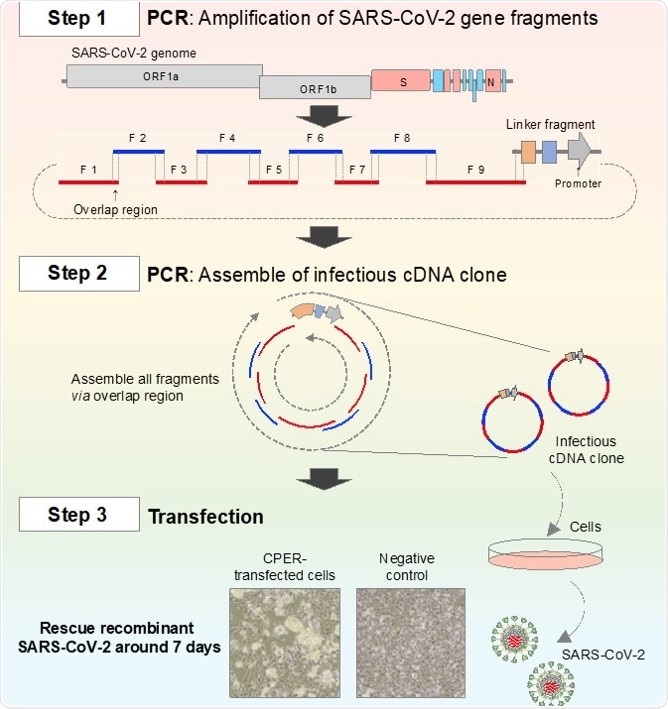The COVID-19 pandemic was caused by the SARS-CoV-2 virus. Although it is known that mutations in the SARS-CoV-2 genome occurred and spread, the effect of those mutations is not clear yet.

Reverse genetics for SARS-CoV-2 by the CPER method: A total of nine gene fragments covering the full-length SARS-Cov-2 genome and a linker fragment were amplified. Because all the fragments were designed to include ends that overlapped with the adjacent fragments, they could be assembled as a circular viral genome by an additional PCR step. Recombinant SARS-CoV-2 was rescued by transfection of the circular viral genome into susceptible cells. Cytopathic effects were only observed in cells transfected with CPER products. Image Credit: Osaka University.
Existing techniques to analyze mutations in the SARS-CoV-2 genome are time-consuming and highly complex since coronaviruses exhibit large genomes. However, researchers from Osaka University and Hokkaido University have now created a fast, PCR-based reverse genetics system to study mutations of the SARS-CoV-2 virus.
This system rebuilds the full-length cDNA of the viral genome by using a circular polymerase extension reaction (CPER) and the polymerase chain reaction (PCR). In this process, bacteria that can introduce further undesirable mutations are not involved. The process requires only two weeks to produce infectious virus particles using simple steps. Earlier techniques required 2 months and were highly complicated processes.
This method allows us to quickly examine the biological features of mutations in the SARS-CoV-2. We can use the CPER technique to create recombinant viruses with each mutation and examine their biological features in comparison with the parental virus.”
Shiho Torii, Study Lead Author, Osaka University
Smaller DNA fragments can be used to develop the huge circular genome of the SARS-CoV-2 virus, which can then be made into a viable viral genome using CPER. This genome can be used to infect suitable host cells. After nine days, a huge amount of infectious virus particles can be recovered.
We believe that our CPER method will contribute to the understanding of the mechanisms underlying propagation and pathogenesis of SARS-CoV-2, as well as help determine the biological significance of emerging mutations. This could accelerate the development of novel therapeutics and preventative measures for COVID-19.”
Yoshiharu Matsuura, Study Corresponding Author, Osaka University
Moreover, the researchers propose that the CPER method will enable scientists to introduce “reporter genes” into the genome of the SARS-CoV-2 virus for “tagging” genes or proteins of interest. This will offer in-depth insights into how the SARS-CoV-2 virus infects cells and causes COVID-19, thereby promoting the development of therapies.
The CPER method could even enable the creation of a recombinant virus that cannot cause disease, and this could serve as a safe, effective vaccine against SARS-CoV-2.
Mutations occur constantly in the SARS-CoV-2 population, and there arise questions about what those mutations cause and whether they could have any impact on the efficacy of vaccines.
Our simple and rapid method allows scientists around the globe to characterize the mutants, which is a vital step forward in our fight against the SARS-CoV-2.”
Takasuke Fukuhara, Osaka University
Source:
Journal reference:
Torii, S., et al. (2021) Establishment of a Reverse Genetics System for SARS-CoV-2 Using Circular Polymerase Extension Reaction. Cell Reports. doi.org/10.2139/ssrn.3714847.